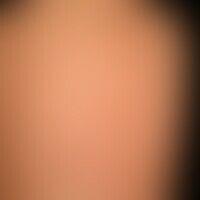Image diagnoses for "Plaque (raised surface > 1cm)"
570 results with 2865 images
Results forPlaque (raised surface > 1cm)
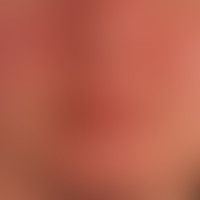
Mixed connective tissue disease M35.10
Mixed connective tissue disease: 43-year-old female patient (with clinical aspect of systemic lupus erythematosus) who fulfils the criteria of MCTD: U1.nRNP : titre : >1:1600; characteristics of systemic lupus erythematosus, Raynaud's phenomenon, swollen hands as well as feeling ill, fatigue, proximal muscle weakness (typical myositis symptoms).

Circumscribed scleroderma L94.0
Circumscripts of scleroderma (plaque-type/variant: Atrophodermia idiopathica et progressiva) Survey picture of the back: size-progressive, large-area, erythematous-livid to brown, confluent, discreetly indurated spots and plaques in the area of the back in a 68-year-old female patient. In the area of the flank and the lumbar spine, clearly sclerosed plaques of whitish colour with partly distinctly atrophic surface and partly livid marginal margins are found.

Pityriasis rosea L42
Pityriasis rosea. truncated, díchtes maculopapular exanthema arranged in the cleft lines, little itching.

Granuloma anulare disseminatum L92.0
Granuloma anulare disseminatum: non-painful, non-itching, disseminated, large-area, anular (only slightly raised) plaques that appeared on the trunk and extremities of a 52-year-old patient. No diabetes mellitus. No other systemic diseases known.
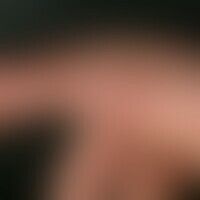
Psoriasis palmaris et plantaris (overview) L40.3
Dry keratotic plaque type Chronically active, intermittent plaques, plaques and rhagades in a 48-year-old man, which have been present for more than 10 years, especially on the palm and fingers, multiple, rough, red, scaly, blurred and blurred spots, plaques and rhagades.

Seborrheic dermatitis of adults L21.9
Dermatitis, seborrhoeic. 6-month-old female patient with almost symmetrical, blurred, flatly infiltrated, scaly, non-itching red plaques. good clinical response to steroidal pre-treatment. recurrence of skin symptoms within a few days after discontinuation of therapy.
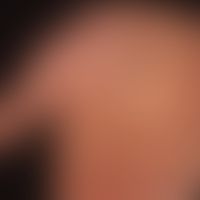
Keratosis palmoplantaris diffusa with mutation in keratin 1 Q82.8
Keratosis extremitatum hereditaria transgrediens et progrediens
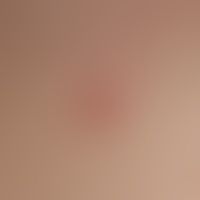
Keratosis benign lichenoid L85.91
Keratosis benigne lichenoide: Reddish plaque of about 1.0 cm on the upper side of the right mamma of a 79-year-old female patient. The patient had noticed relatively fast growth and therefore presented with malignancy. The tissue biopsy showed a lichenoid keratosis.

Lichen planus mucosae L43.8
Lichen planus mucosae: a disorderly transformation of the lesions on the lips and oralmucosa.

Eyelid dermatitis (overview) H01.11
Contact allergic eyelid eczema. chronic recurrent course. complete intolerance of all eyelid cosmetics. on the left side of the patient distinct marginal scattering reaction.

Transitory acantholytic dermatosis L11.1
Transitory acantholytic dermatosis. 6-8 weeks of slowly progressive moderately pruritic, truncal exanthema in a 53-year-old man. Red, 2-5 mm large, flat papules confluent at the sternum to plaques of about 3 cm diameter.

Chilblain lupus L93.2
Chilblain-Lupus: flat and bizarre livedo-like, blue-reddish and red discoloration of the toes.
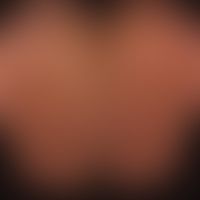
Keratosis palmoplantaris diffusa with mutation in keratin 1 Q82.8
Keratosis extremitatum hereditaria transgrediens et progrediens Diffuse palmoplantar keratosis with verrucous (not smooth) "transgenic" keratinization.

Atopic anal dermatitis L20.8
Eczema, anal eczema, atopic dermatitis, chronic ekezmatouschanges of the perianal region with known atopic diathesis.

Mycosis fungoides C84.0
Mycosis fungoides: Tumor stage. 53-year-old man with multiple, disseminated, 1.0-5.0 cm large, in places also large-area, moderately itchy, clearly consistency increased, red, rough, eroded plaques. development over 4 years.
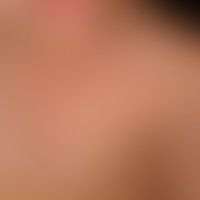
Nevus verrucosus Q82.5
Nevus verrucosus in a 9-month-old infant. No symptoms. Verucosal papules and plaques running in the Blaschko lines.







